Recently, I’ve encountered an interesting diagnosis in several L&I claim matters in Washington State. The name of the condition is diffuse idiopathic skeletal hyperostosis (or DISH in short). It relates to arthritis mostly around the spine. Sometimes, we encounter the condition in the context of work injury involving the lower or upper back.
Arthritis in the spine area
Diffuse idiopathic skeletal hyperostosis is an arthritic condition. It happens when various musculoskeletal structures such as ligaments and tendons harden overtime. The condition is most common around the ligaments and tendons of the spine. However, it can also manifest itself in the hips, knees, shoulders, feet, and hands.
Some of the most common symptoms include stiffness, decreased mobility, and pain. After a work injury, many people report experiencing the symptoms especially upon waking in the morning. Over time, diffuse idiopathic skeletal hyperostosis can cause bone spurs around the affected areas. Then, if bone spurs form, they can also cause additional inflammation and impact nerves in the area. Unfortunately, depending on the areas in question, bone spurs that impact nerves can become quite dangerous. Moreover, they require surgical intervention. However, it’s important to note that many people do not experience any symptoms. Frequently, medical doctors diagnose the condition after performing imaging studies following an acute workplace injury.
A unique arthritis condition
Interestingly, diffuse idiopathic skeletal hyperostosis is largely an asymptomatic condition. On top, it’s an interesting condition for other reasons. First, medical professionals still do not fully understand its causes. In fact, various medical sources suggest that causes include genetics and the aging process. Some studies imply causes such as inflammation, metabolism, and possibly body mechanics. Furthermore, another interesting feature of the condition is that it impacts certain types of people. For example, it’s more frequent in men, especially over 50 years old.
Individuals who have diabetes or conditions that raise insulin levels also have higher likelihood of developing the condition. Additionally, researchers found some connections to certain acne medication and excessive vitamin A intake or production. Finally, other sources found that diffuse idiopathic skeletal hyperostosis might relate to repetitive heavy lifting.
Challenging condition in the workers’ compensation claim setting
We can all agree that this type of arthritis has unusual features. Also, it can be very difficult to diagnose the condition. Hence, it’s also difficult to handle diffuse idiopathic skeletal hyperostosis under an L&I claim. Personally, in the cases I encounter, the individuals didn’t know they had the condition. Surprisingly, doctors discovered the condition while treating clients after an industrial injury or workplace accident.
Naturally, the discovery of the condition raises questions about the origins of the symptoms that these individuals are experiencing. Do their symptoms originate from their work injury? Do their symptoms originate from diffuse idiopathic skeletal hyperostosis? Is it a combination of the two? Would the condition become symptomatic if it wasn’t for the industrial injury?
Conclusion
We have to leave these questions to the medical experts to answer. However, the difficulty is that there’s a lack of consensus amongst medical professionals. Therefore, it is common to have differing opinions in response to each of these questions. Consequently, it means that there’s much higher likelihood to run into disputes when encountering the condition in an L&I claim or self-insured employer claim. Should L&I cover the condition under the claim? If not, why not? And so on.
Some work injury claimants intend to pursue acceptance of the condition under their workers’ compensation claim. Therefore, it’s important to have strong medical opinion. These medical opinions must explain the causal connection in light of the unique nature of this condition.

Thank you for shedding light on the complexities of diffuse idiopathic skeletal hyperostosis. Your insights are greatly appreciated!